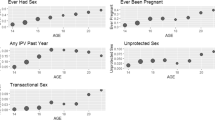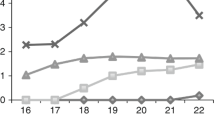Abstract
Emerging adulthood is a transitional time often marked by instability in many areas of life, including residential status, work, school, and romantic relationships. The purpose of this study is to examine transitions in HIV-risk related behaviors among a cohort of ethnically-diverse young men who have sex with men (YMSM) and to reveal how changes in developmental contexts during emerging adulthood might be associated with these behavioral changes. Hidden Markov models were used to examine movement across different stages of behavioral risk-taking over time. Semi-annual surveys were administered across 2 years; analyses included those with at least three of the five waves of data. Results indicated substantial movement at the individual-level transitions. Additionally, high variability in sexual risk, alcohol misuse, and illicit drug-risk behaviors was predicted by age, ethnicity, and correlates of emerging adulthood, such as residential status, work, post-secondary school enrollment, and primary-relationship status. Findings provide evidence of great change in risky behaviors among YMSM during this pivotal time, particularly among those who actively experiment in varying levels of risk-taking. In order to prevent experimental behaviors from evolving into more serious risk, interventions must consider ways to assist YMSM to adjust to life changes brought on by emerging adulthood.


Similar content being viewed by others
Notes
Hidden Markov modeling is also known as manifest Markov modeling (Kaplan 2008). We retain the terminology “hidden Markov model” throughout this paper to best convey the way these analyses are performed in Mplus, which specifies a Markov process “hidden” inside a latent class framework.
Unlike the sex risk and alcohol use variables, for which the transition between higher groups and the lowest group was meaningful, it is not possible to become a lifetime non-user after engaging in any drug use. Therefore, the transition probabilities for the transitions between each prior or current usage group (groups 2, 3, and 4) and the lifetime non-use group (group 1) were fixed to zero between each wave.
Conceptually, this was true at waves 3 and 5 as well, but the corresponding parameters were fixed at these waves due to empty cells in the contingency tables between relationship status and sexual risk. That is, there were no participants in primary-partner relationships at waves 3 and 5 who reported having no sexual partners in the past 3 months.
References
Arnett, J. J. (2005). The developmental context of substance use in emerging adulthood. Journal of Drug Issues, 35, 235–253.
Bachman, J. G., Wadsworth, K., O’Malley, P., Johnston, L., & Schulenberg, J. (1997). Smoking, drinking, and drug use in young adulthood: The impacts of new freedoms and new responsibilities. Mahway, NJ: Lawrence Erlbaum Associates.
Bailey, J. A., Haggerty, K. P., White, H. R., & Catalano, R. F. (2011). Associations between changing developmental contexts and risky sexual behavior in the two years following high school. Archives of Sexual Behavior, 40, 951–960.
Bauermeister, J. A., Johns, M. M., Sandfort, T. G., Eisenberg, A., Grossman, A. H., & D’Augelli, A. R. (2010). Relationship trajectories and psychological well-being among sexual minority youth. Journal of Youth and Adolescence, 39, 1148–1163.
Borsari, B., & Carey, K. B. (2003). Descriptive and injunctive norms in college drinking: A meta-analytic integration. Journal of Studies on Alcohol, 64, 331–341.
Caetano, R., & Kaskutas, L. A. (1995). Changes in drinking patters among Whites, Blacks and Hispanics, 1984–1992. Journal of Studies on Alcohol, 56, 558–565.
Centers for Disease Control and Prevention. (2010). HIV/AIDS surveillance report, 2009. Atlanta: Centers for Disease Control and Prevention.
Choi, K. H., Han, C., Hudes, E. S., & Kegeles, S. M. (2002). Unprotected sex and associated risk factors among young Asian and Pacific Islander men who have sex with men. AIDS Education and Prevention, 14, 472–481.
Clatts, M., Goldsamt, L., Yi, H., & Gwadz, M. (2005). Homelessness among young men who have sex with men in New York city: A preliminary epidemiological trajectory. Journal of Adolescence, 28, 201–214.
D’Augelli, A., & Herschberger, S. (1993). Lesbian, gay, and bisexual youth in community settings: Personal challenges and mental health problems. American Journal of Community Pscyhology, 21, 421–448.
Dudley, M. G., Rostosky, S. S., Korfhage, B. A., & Zimmerman, R. S. (2004). Correlates of high-risk sexual behavior among young men who have sex with men. AIDS Education and Prevention, 16, 328–340.
Flora, D. B., & Chassin, L. (2005). Changes in drug use during young adulthood: The effects of parent alcoholism and transition into marriage. Psychology of Addictive Behaviors, 19, 352–362.
Hatzenbuehler, M. L., Corbin, W. R., & Fromme, K. (2008). Trajectories and determinants of alcohol use among LGB young adults and their heterosexual peers: Results from a prospective study. Developmental Psychology, 44, 81–90.
Huebner, D. M., Rebchook, G. M., & Kegeles, S. M. (2004). A longitudinal study of the association between treatment optimism and sexual risk behavior in young adult gay and bisexual men. Journal of Acquired Immune Deficiency Syndromes, 37, 1514–1519.
Kaplan, D. (2008). An overview of Markov chain methods for the study of stage-sequential developmental processes. Developmental Psychology, 44, 457–467.
Kipke, M. D., Kubicek, K., Weiss, G., Wong, C. F., Lopez, D., Iverson, E., et al. (2007a). The health and health behaviors of young men who have sex with men. Journal of Adolescent Health, 40, 342–350.
Kipke, M. D., Weiss, G., & Wong, C. F. (2007b). Residential status as a risk factor for drug use and HIV risk among YMSM. AIDS and Behavior, 11, 56–69.
Kubicek, K., Carpineto, J., McDavitt, B., Weiss, G., Au, C. W., Kerrone, D., et al. (2008). Integrating professional and folk models of HIV risk: YMSM’s perceptions of high-risk sex. AIDS Education and Prevention, 20, 220–238.
Lanza, S. T., & Collins, L. M. (2008). A new SAS procedure for latent transition analysis: Transitions in dating and sexual risk behavior. Developmental Psychology, 44, 446–456.
MacKellar, D. A., Valleroy, L. A., Karon, J. M., Lemp, G. F., & Janssen, R. S. (1996). The Young Men’s Survey: Methods for estimating HIV seroprevalence and risk factors among young men who have sex with men. Public Health Reports, 111, 138–144.
McNall, M., & Remafedi, G. (1999). Relationship of amphetamine and other substance use to unprotected intercourse among young men who have sex with men. Archives of Pediatrics and Adolescent Medicine, 153, 1130–1135.
Merline, A. C., O’Malley, P. M., Schulenberg, J. E., Bachman, J. G., & Johnston, L. D. (2004). Substance use among adults 35 years of age: Prevalence, adulthood predictors, and impact of adolescent substance use. American Journal of Public Health, 94, 96–102.
Muhib, F., Lin, L., Steuve, A., Miller, R., Ford, W., Johnson, W., et al. (2001). The Community Intervention Trial for Youth (CITY) Study team: A venue-based method for sampling hard to reach populations. Public Health Reports, 116, 216–222.
Muthén, L. K., & Muthén, B. O. (1998–2011). Mplus User’s Guide. Los Angeles, CA: Muthén & Muthén.
Needham, B. L. (2012). Sexual attraction and trajectories of mental health and substance use during the transition from adolescence to adulthood. Journal of Youth and Adolescence, 41, 179–190.
O’Malley, P., & Johnston, L. D. (2002). Epidemiology of alcohol and other drug use among American college students. Journal of Studies on Alcohol, Suppl 14, 23–29.
Presley, C. A., & Pimental, E. R. (2006). The introduction of the heavy and frequent drinker: A proposed classification to increase accuracy of alcohol assessments in postsecondary educational setting. Journal of Studies on Alcohol, 67, 324–331.
Raskin White, H., & Jackson, K. M. (2004/2005). Social and psychological influences on emerging adult drinking behavior. Alcohol Research and Health, 28, 182–190.
Rohrbach, L. A., Sussman, S., Dent, C. W., & Sun, P. (2005). Tobacco, alcohol and other drug use among high-risk young people: A five-year longitudinal study from adolescence to emerging adulthood. Journal of Drug Issues, 35, 333–356.
Rosario, M., Schrimshaw, E. W., & Hunter, J. (2004). Predictors of substance use over time among gay, lesbian, and bisexual youths: An examination of three hypotheses. Addictive Behaviors, 29, 1623–1631.
Rotheram-Borus, M. J., Rosario, M., Van Rossem, R., Reid, H., & Gillis, R. (1995). Prevalence, course, and predictors of multiple problem behaviors among gay and bisexual male adolescents. Developmental Psychology. Special Issue: Sexual Orientation and Human Development, 31, 75–85.
Savin-Williams, R. (1990). Gay and lesbian youth: Expressions of identity. New York: Hemisphere.
Sneed, C., Morisky, D., Rotheram-Borus, M. J., Ebin, V. J., & Malotte, C. K. (2001). Patterns and predictors of adolescent alcohol, cigarette, and marijuana use over a six-month period. Addictive Behaviors, 26, 415–423.
Steinberg, L. (2007). Risk taking in adolescence: New perspectives from brain and behavioral science. Current Directions in Psychological Science, 16, 55–59.
Tucker, J. S., Ellickson, P. L., Orlando, M., Martino, S. C., & Klein, D. J. (2005). Substance use trajectories from early adolescence to emerging adulthood: A comparison of smoking, binge drinking, and marijuana use. Journal of Drug Issues, 5, 307–332.
Valleroy, L. A., MacKellar, D. A., Karon, J. M., Rosen, D. H., McFarland, W., & Shehan, D. A. (2000). HIV prevalence and associated risks in young men who have sex with men. Journal of American Medical Association, 284, 198–204.
White, H. R., Fleming, C. B., Kim, M. J., Catalano, R. F., & McMorris, B. J. (2008). Identifying two potential mechanisms for changes in alcohol use among college-attending and non-college-attending emerging adults. Developmental Psychology, 44, 1625–1639.
Wong, C. F., Kipke, M. D., & Weiss, G. (2008). Risk factors for alcohol use, frequent use, and binge drinking among young men who have sex with men. Addictive Behaviors, 33, 1012–1020.
Wong, C. F., Kipke, M. D., Weiss, G., & McDavitt, B. (2010a). The impact of recent stressful experiences on HIV-risk related behaviors among YMSM. Journal of Adolescence, 33, 463–475.
Wong, C. F., Weiss, G., Ayala, G., & Kipke, M. D. (2010b). Harassment, discrimination, violence, and illicit drug use among YMSM. AIDS Education and Prevention, 22, 286–298.
Author information
Authors and Affiliations
Corresponding author
Rights and permissions
About this article
Cite this article
Wong, C.F., Schrager, S.M., Chou, CP. et al. Changes in Developmental Contexts as Predictors of Transitions in HIV-Risk Behaviors Among Young Men Who Have Sex with Men (YMSM). Am J Community Psychol 51, 439–450 (2013). https://doi.org/10.1007/s10464-012-9562-2
Published:
Issue Date:
DOI: https://doi.org/10.1007/s10464-012-9562-2




